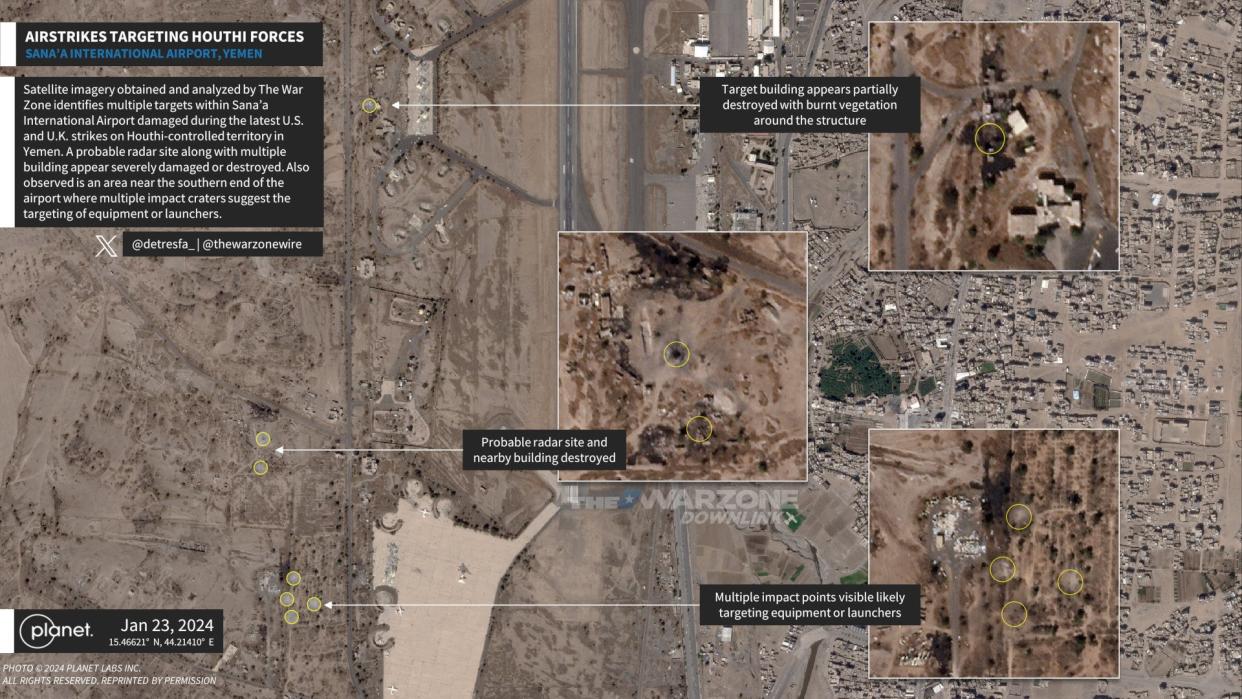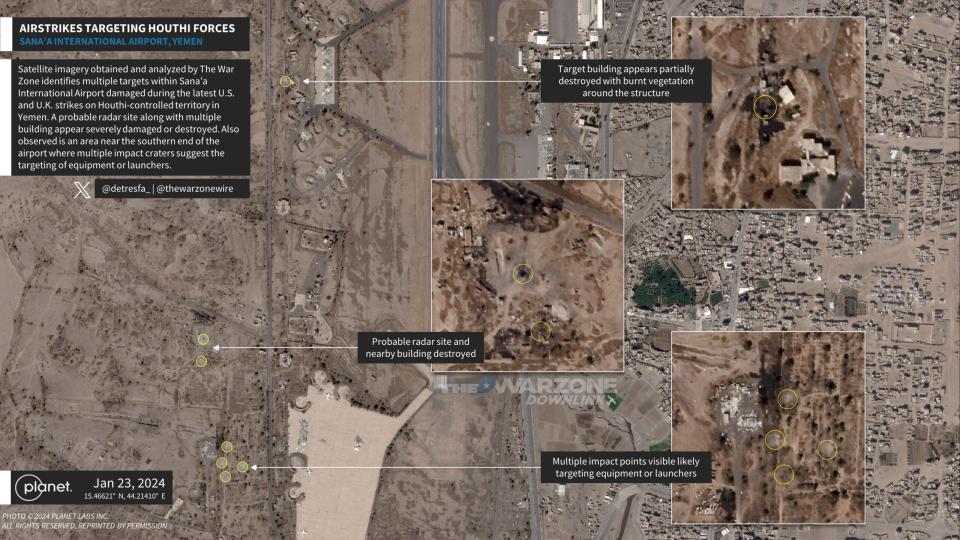Damage Analysis From Yesterday's Strikes On Airport In Yemen's Capital

Satellite imagery The War Zone has obtained from Planet Labs shows the results of U.S. and U.K. strikes overnight on the main airport in the Yemeni capital Sanaa. The airport was among the locations targeted as part of ongoing U.S.-led efforts to degrade the capabilities of Iranian-backed Houthi militants, particularly the group's ability to launch missile and drone attacks on ships in and around the Red Sea. You can read more about what is already know about last night's strikes in our initial reporting here.
The annotated satellite image below, which was taken earlier today and focuses on the southern end Sanaa International Airport, was produced for The War Zone by @detresfa_. Visible are multiple structures and what may have been a radar site that appear to have been damaged or destroyed. Other impact points could indicate where Houthi missile launchers or other key materiel was positioned.

At the time of writing, in total, there have been two U.S.-British combined strikes and six unilateral U.S. strikes on Houthi targets since January 11. The Pentagon disclosed today that within 15 to 30 minutes of the larger U.S. and U.K. strikes last night, American forces also unilaterally targeted an anti-ship cruise missile being prepared or launch.
In terms of the American and British combined strikes last night, four Royal Air Force (RAF) Typhoon fighters employed an unspecified number "of [500-pound-class] Paveway IV precision guided bombs to strike multiple targets at two military sites in the vicinity of Sanaa airfield," according to statement the U.K. Ministry of Defense released late yesterday.
Based on the satellite image from Planet Labs, the RAF aircraft could have accounted for much of the damage seen today at the airport in the Yemeni capital. What was struck in Sanaa looks to have largely been softer targets against which the 500-pound Paveway IVs may have been better suited.
Aircraft flying from the U.S. Navy's supercarrier USS Dwight D. Eisenhower also struck targets at unspecified locations in Yemen last night using precision-guided munitions, according to a senior U.S. military official. The Ticonderoga class guided missile cruiser USS Philippine Sea, and the Arleigh Burke class guided missile destroyers USS Gravely and USS Mason fired Tomahawk land attack cruise missiles, as well.
U.S. Central Command (CENTCOM) said in a statement afterward that the "targets included missile systems and launchers, air defense systems, radars, and deeply buried weapons storage facilities."
This in line with what can be seen the video below, which was shot aboard Eisenhower as aircraft launched to take part in the strikes. One clip shows an F/A-18F Super Hornet armed with 2,000-pound class GBU-31 Joint Direct Attack Munition (JDAM) with a BLU-109/B 'bunker buster' bomb body. An EA-18G Growler loaded with AGM-88 radar-busting anti-radiation missiles appears later on. Its unknown whether Growlers actually fired any AGM-88s, or just provided electronic attack and suppression capabilities during the mission. An E-2 Hawkeye airborne early warning and control aircraft is also visible in the footage.
Questions remain about the broader impacts U.S.-led strikes in Yemen are having against the Houthis.
"CENTCOM is continuing to assess the outcomes of the strikes [last night]," U.S. Air Force Brig. Gen. Pat Ryder, the Pentagon's top spokesman, told reporters from the The War Zone and other outlets at a press conference today. "So I don't have anything specific on that other than to say that we believe that we achieved good effects."
"I can tell you that, since January 11, we assess that we've destroyed or degraded over 25 missile launch and deployment facilities [and] more than 20 missiles," Ryder continued. "Plus we've struck unmanned aerial vehicle, coastal radar, and air surveillance capabilities, as well as weapons storage areas with good effects. We'll continue to assess and provide you updates as we're able to."
The Houthis have amassed a significant arsenal of anti-ship ballistic and cruise missiles over the years, and are the first to fire the former in anger. The group has a plethora of aerial drones, as well as explosive-laden uncrewed kamikaze boats and naval mines, too.
Though the Iranian-backed Yemeni militants have not succeeded in sinking a ship or causing any casualties in their attacks, their arsenal represents a real threat. This can be seen in pictures in the social media post below of the aftermath of a missile attack that damaged the bulk carrier M/V Zografia in the Red Sea last week. The missile passed through the ship's upper deck and exited the lower side of the hull. It's possible its main warhead failed to detonate, but that residual fuel in the weapon exploded when it struck. It remains unclear whether this was an anti-ship ballistic or cruise missile and you can read more about this particular incident here.
"We have been very focused on targeting the kinds of things that they've been employing, or using to conduct attacks against international shipping and mariners, and that will continue to be our focus," Ryder added today. "The last Houthi attack that I'm tracking was on the 18th of January."
That being said, international shipping through this highly strategic region remains heavily disrupted amid continued fears about Houthi attacks. Recent reports have also suggested that the U.S. military may be considering further escalating its operations against the Houthis, which have raised concerns about the potential for a larger conflict that could spread further throughout the region.
At least some portion of the current U.S. campaign against the Houthis has reportedly been dubbed Operation Poseidon Archer, which could be a sign of a more formalized, long-term effort. At the same time, a significantly more intricate, sustained and costly campaign that involves persistent presence over and near Houthi territory would be need to dramatically the group's capabilities, as The War Zone has previously highlighted.
The U.S. and U.K. strikes overnight on the airport in Sanaa, which we have now seen the aftermath of, and elsewhere in Yemen certainly point to operations against the Houthis continuing for the foreseeable future.
Contact the author: joe@thedrive.com

